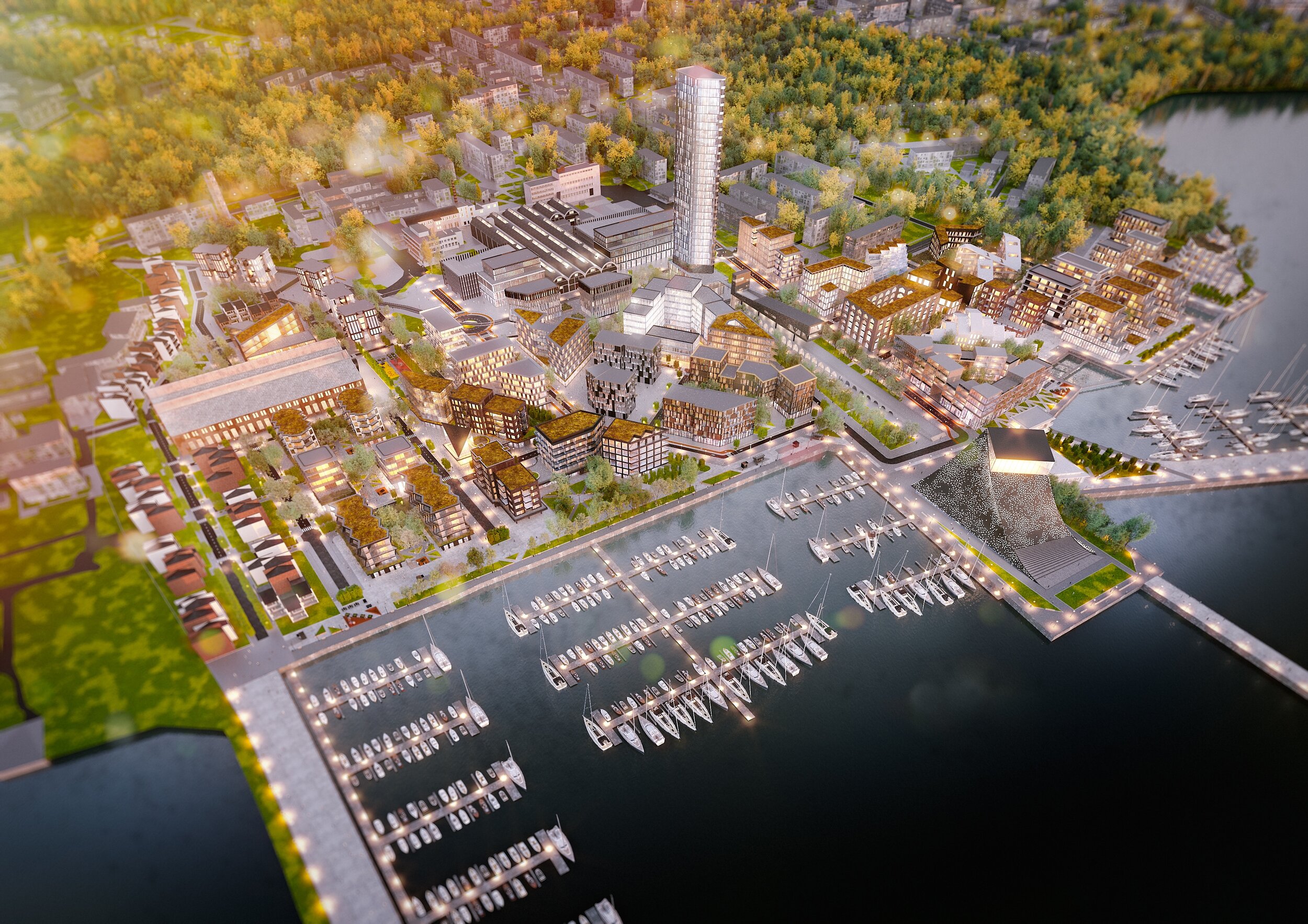Bekker Port today
The Bekker site today operates as a cargo port on the western coast of Kopli peninsula in Tallinn. The combined area of Bekkeri and Meeruse is 26.1 hectares. To put that into perspective, the size of Tallinn Old Town is 35.3 hectares.
It is rare for such a large contiguous area in any city to be available for redevelopment. This offers up a unique opportunity to build a new district with necessary supporting amenities and utilities.
Bekkeri City tomorrow
In collaboration with KTA-Kadarik Tüür Arhitektid a new urban space that blends into the existing urban fabric and enhances the local qualities is proposed:
Bekkeri City combines the Bekkeri Quarter and Meeruse developments on their respective sites.
District level planning
The scale of the proposal is that of a district which allows for not only mixed residential and retail structures but to create a resilient green city with multifunctional sites. While the centre is lively, the outskirts are reserved for peaceful residential housing.
A wide variety of building and street typologies along with diverse urban densities has been laid out so that the centre and seaside promenade can provide sufficient flows of people and movement for ground floor cafes, restaurants and boutiques as well as bigger stores, gyms, spas and movie theatres to thrive. A school, kindergarden, sports centre, spaces for co-working offices are also planned.
Centralised district heating or cooling will be provided utilising seawater.
A 15 minute city - inside and out
Bekker City has an ideal scale for residents to traverse on foot and bicycle in 15 minutes, comfortably and safely. A car is not obligatory with all daily services situated in the area. Future tram and bus lines connect habitants to the centre of Tallinn in less than 15-minutes.
Returning public access to Kopli
Closed to the public since 1914, the Kopli coastline will be opened up. Public spaces will be created utilising the industrial heritage. The boat slip will be converted into a Spa with surrounding park. Space is also made available to home Estonia’s opera house, ending the search for a new location since re-independence.
FAQs
Q: Do we need another development in Tallinn?
Tallinn is growing but existing individual plots are not meeting residents needs
With the population of Tallinn increasing by 10% in the past 10 years there is an ever growing need to provide high quality housing.
However, with property prices almost doubling in the same 10 year period it is clear that supply of individual plots for development in Tallinn are quickly being depleted and not keeping up with demand. These joint pressures have meant that property transactions already stagnated, even ahead of 2020.
There is a need to create a new swathe of affordable housing in Tallinn. However housing alone is not the answer.
Q: Why should Bekkeri be redeveloped?
It’s better to redevelop brownfield sites rather than expand into greenfield. The old industrial coastline can be opened once again to the community.
As Tallinn grows, we are left with the choice of expanding further into the green suburbs and nature that exist beyond the city, increasing commuter traffic as a result, or redeveloping brownfield sites in Tallinn to meet the demand.
The population growth in Tallinn today is shifting the centre of the city to the West. Tallinn grew fastest in the Kesklinn (+ 2.5%) and Haabersti (+ 1.4%) districts last year. Alongside growing developments into northwest Tallinn in recent years, Bekkeri offers a unique site to support the demand for seaside property in the west of the city.
Today however the Bekkeri territory is off-limits to the public, operating as a bulk cargo port. Access roads pass both through residential housing and the growing community of Põhjala tehas. As a site operating 24/7, even at weekends, it is common for up to 500 heavy trucks a day to pass through. For years local residents have been unhappy with the level of noise, dust and heavy machinery driving through the neighbourhood.
Reinventing this industrial site will not only open up the coast to local people, but will create a greener and cleaner environment for future generations to enjoy.
Q: Why so big? Why does the whole site have to be developed?
Only building at district level allows the collective needs of the city to be met. This is the driving force behind Bekkeri City
Each apartment conceived and built individually creates new homes, but does not contribute to the wider needs of the city either to support a good life with good schools, healthcare, workplaces and recreation facilities.
District level development also enables investment into shared infrastructure such as district heating to reduce energy costs of residents.
If only part of the site is developed, then port operations will continue without removal of the traffic and noise that this creates.
Q: Isn’t traffic already an issue in Kopli today?
There are differing opinions, but what is for certain is that Kopli today has much lower levels of transit than it did back during it’s peak in the Soviet era. Over 34,000 people travelled into Kopli everyday by road and tram, some 10% of the Tallinn metro area at that time.
To minimise any increase in traffic additional measures are being taken:
Designed as a ‘15-minute city’, with all daily services easily accessible on site , there is reduced need to travel out of the area for day to day living.
Traversing Bekkeri City can be achieved comfortably and safely via pedestrian and cycle paths. A car is not obligatory.
For longer journeys, extensions of tram and bus lines to the centre of the district will enhance existing public transport and allow more convenient journeys to the central train station in under 15 minutes.
The removal of heavy traffic loads that supply the operating port will provide additional benefits - up to 500 trucks a day will be taken off of Kopli’s streets.
Q: How will you lower the impact on the environment?
District heating utilising seawater
Seawater can be used as a thermal energy source, even in the winter, to help reduce the ongoing cost of heating and the impact on the environment through reducing the use of traditional fuel sources.
How does it work?
Centralised heating requires a readily available heat source and utilises this more efficiently than if consumed in individual buildings. If a green fuel source is used this helps reduce greenhouse gas emissions even further. In Bekkeri City the direct access to ice free seawater year round provides the ideal thermal energy source.
Seawater enable central heating plants consist of a system that extracts seawater and processes it via either a heat exchanger in summer months or a heat pump in winter (as different water temperatures require slightly different systems to utilise). The thermal energy extracted is used to heat water that is then distributed through insulated pipes to connected properties for hot water or for heating. As a result, connected buildings only need to top up the warm water with their systems rather than individually heating cold water.
The energy yield by drawing heat from the sea in similar projects has been observed to be as high as 1,100%, in turn resulting in up to a 50% reduction in CO2 emissions.
What are the benefits?
Residents do not pay more for seawater heating, and may pay less, while being kinder on the environment. Benefits are compounded by using seawater heating centrally which is possible in Bekkeri.
Has it been done elsewhere?
Yes. The Tallinn Seaplane Harbor is the best-known example in Estonia where seawater is being leveraged for both heating and cooling. The solution supplies this single building, however a similar system can be utilised to supply multiple buildings if designed and built as an integrated system.





